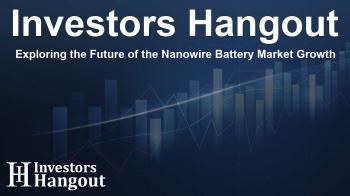Exploring the Future of the Nanowire Battery Market Growth

Nanowire Battery Market: Growth Projections and Insights
The nanowire battery market is rapidly gaining traction, with a substantial anticipated growth that will see market value grow from USD 76.39 million in 2023 to a staggering USD 1111.61 million by 2032. This surge is driven by advancements in nanotechnology and increasing demand for efficient energy storage solutions.
Material Innovations Driving Market Expansion
One of the primary factors fueling the growth of this market is the innovation in materials, specifically the developments surrounding silicon nanowires. These materials are known for significantly enhancing battery life and performance, making them ideal candidates in a world increasingly reliant on energy efficiency.
As pilot-scale production gains momentum and manufacturing processes improve, we've witnessed an uptick in capacity utilization rates, reaching approximately 85%. This improvement allows manufacturers to produce batteries with an energy density of 400 Wh/kg, showcasing a remarkable 20% increase from earlier models.
The Impact of Consumer Demand on Production
The demand for compact and high-capacity batteries in electric vehicles, aerospace, and consumer electronics is a crucial driver. In the U.S. market alone, the nanowire battery segment was valued at USD 21.83 million in 2023, indicating robust growth anticipated at a CAGR of 34.49%. The escalating requirements for energy storage solutions in various sectors underpin this progress.
Key Market Players and Competitive Landscape
A variety of players lead the charge in the nanowire battery market, each contributing innovations that shape the future of battery technology. Key companies involved include:
- Amprius Technologies, known for their 450 Wh/kg batteries.
- Nexeon with their silicon nanowire anode materials.
- OneD Battery Sciences, popular for their Sinanode technology.
- Sila Nanotechnologies offers Titan Silicon™ batteries.
- Enovix Corporation with BrakeFlow™ Battery technology.
- Leading brands such as Samsung SDI, Panasonic Corporation, and LG Energy Solution are also making significant strides with their innovations in nanowire technology.
Emerging Opportunities and Related Trends
The convergence of several industries, including automotive and consumer electronics, creates an abundance of opportunities for nanowire batteries. As electric vehicles gain popularity, the performance requirements for batteries increase, demanding longer lifespans and ultra-fast charging capabilities.
Regional Insights: North America and Asia Pacific
North America currently holds the largest share of the nanowire battery market, accounting for 35.7% in 2023. This dominance comes from substantial investments in battery R&D and the increasing implementation of electric vehicle technology. Supportive government programs and academic partnerships greatly enhance commercial prospects in the region.
Meanwhile, the Asia Pacific region is set to experience the fastest growth during the forecast period. This is largely due to rapid industrialization, increasing electric vehicle production, and heightened consumer electronics demand, particularly in countries like China, Japan, and South Korea.
Future Development and Research Directions
As the world leans towards renewable energy and sustainable solutions, the nanowire battery market must evolve with promising innovations. Companies like Amprius Technologies are already at the forefront, showcasing advancements like their SiMaxx A-Sample EV cells that charge quickly and provide high energy density. This continuous evolution speaks to the vibrancy of the market and its potential to redefine energy storage technologies.
Frequently Asked Questions
What is the expected market growth for nanowire batteries?
Analysts project the nanowire battery market will grow from USD 76.39 million in 2023 to USD 1111.61 million by 2032, presenting an impressive CAGR of 34.71%.
Which materials are primarily used in nanowire batteries?
The most notable materials used in nanowire batteries include silicon, germanium, and transition metal oxides, which help enhance battery performance and longevity.
What industries are driving the demand for nanowire batteries?
The consumer electronics, automotive, aviation, and healthcare industries are significant drivers of demand, as these sectors increasingly require efficient energy storage solutions.
Who are the major competitors in the nanowire battery market?
Leading companies in this market include Amprius Technologies, Nexeon, Sila Nanotechnologies, and several others, each innovating to capture market share.
What regions show the highest growth potential for nanowire batteries?
North America currently leads, but the Asia Pacific is expected to grow the fastest due to industrialization and demand for electric vehicles and consumer electronics.
About The Author
Contact Hannah Lewis privately here. Or send an email with ATTN: Hannah Lewis as the subject to contact@investorshangout.com.
About Investors Hangout
Investors Hangout is a leading online stock forum for financial discussion and learning, offering a wide range of free tools and resources. It draws in traders of all levels, who exchange market knowledge, investigate trading tactics, and keep an eye on industry developments in real time. Featuring financial articles, stock message boards, quotes, charts, company profiles, and live news updates. Through cooperative learning and a wealth of informational resources, it helps users from novices creating their first portfolios to experts honing their techniques. Join Investors Hangout today: https://investorshangout.com/
The content of this article is based on factual, publicly available information and does not represent legal, financial, or investment advice. Investors Hangout does not offer financial advice, and the author is not a licensed financial advisor. Consult a qualified advisor before making any financial or investment decisions based on this article. This article should not be considered advice to purchase, sell, or hold any securities or other investments. If any of the material provided here is inaccurate, please contact us for corrections.

